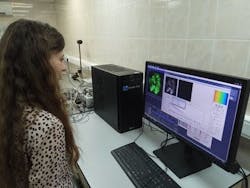Fluorescence imaging technique goes from micro to macro, moves closer to clinic
Researchers from Becker & Hickl (Berlin, Germany), Privolzhsky Research Medical University (izhny Novgorod, Russia), and Shemyakin-Ovchinnikov Institute of Bioorganic Chemistry (Moscow, Russia) have scaled up a powerful fluorescence imaging technique—fluorescence-lifetime imaging microscopy (FLIM)—used to study biological processes on the cellular level. Previously limited to samples just millimeters in area, the expanded approach can analyze samples with areas up to 4 cm2.1 With further development, the new approach could find use in the clinic as a sensitive and precise method for identifying the edges of tumors during surgery.
"Our macro-FLIM system can not only obtain a sample’s structural information, but also allows observation of certain biochemical processes taking place within the sample," says senior research scientist Vladislav Shcheslavskiy from Becker & Hickl. "Although our goal is to develop this for clinical use, it could also be very useful in fundamental studies for probing biological processes as disease develops or investigating biological responses to different types of therapy."
The researchers demonstrate the first confocal microscopy based macro-FLIM system with cellular resolution and high molecular sensitivity. They used it to observe the metabolic processes inside a whole tumor in a live mouse, a feat that isn’t possible with current FLIM systems.
In addition to biological and clinical samples, the new macro-FLIM system could be used to analyze other samples with large areas. For example, it could offer a nondestructive method for determining the media used in paintings that need restoring.
Getting more information from fluorescence
FLIM involves precise measurements of the fluorescence decay rate of a naturally fluorescent molecule or a fluorescent label that has been added to tissue. Because the lifetime depends on characteristics of a molecule's environment such as temperature and pH as well as on its interaction with other surrounding molecules, FLIM can be used to obtain information about the properties of the molecule and its micro-environment.
Typically, FLIM is performed using laser scanning confocal microscopy, which achieves high resolution by scanning a laser beam across a fluorescent sample to form an image. To obtain FLIM information on a macroscopic scale, the researchers developed a confocal macroscopy system that incorporates pcosecond-pulse lasers along with very sensitive detectors to sense the fluorescence. The system also includes electronics that count the photons and plot their distribution in relation to the time since the laser pulse and the position of the laser beam on the sample.
"Careful optical design along with the picosecond lasers, sensitive and fast detectors and fast single photon counting electronics allowed us to record fluorescence decay with high precision at macroscale," says Shcheslavskiy.
Confocal microscopy is typically limited to an imaging area of just millimeters, but placing the samples in the macroscanner's intermediate image plane allowed the researchers to image larger samples. They then plotted the photon distributions across a large area of the sample to acquire macro-scale fluorescence lifetime information.
Testing in cancerous tissue
To demonstrate the cellular resolution of the macro-FLIM system, the researchers used it to image fluorescent microbeads with a diameter of 14.6 microns and live cultured cancer cells labeled with fluorescent dye.
They then used the macro-FLIM system to analyze an entire tumor in a live mouse. They did this by simultaneously measuring the fluorescence lifetime of a genetically encoded red fluorescent protein, which identified the location of the tumor, and nicotinamid adenine dinucleotide (NADH), a molecule responsible for energy production in living cells.
"The sensitivity of our system was high enough to observe fluorescence of intrinsic tissue components such as NADH without any labeling," says Shcheslavskiy. "In addition to being used to study metabolism in a tumor, macro-FLIM could be used to follow cell death or oxygen status of tumors on a macroscale with cellular resolution."
To develop the system for clinical applications, the researchers are working to improve its flexibility and mobility. They also want to combine the macro-FLIM system with a scanning stage that would move the sample to allow FLIM to be performed on areas as large as 10 by 10 cm.
REFERENCE:
1. V. I. Shcheslavskiy et al., Optics Letters (2018); doi: 10.1364/OL.43.003152.
About the Author
John Wallace
Senior Technical Editor (1998-2022)
John Wallace was with Laser Focus World for nearly 25 years, retiring in late June 2022. He obtained a bachelor's degree in mechanical engineering and physics at Rutgers University and a master's in optical engineering at the University of Rochester. Before becoming an editor, John worked as an engineer at RCA, Exxon, Eastman Kodak, and GCA Corporation.

